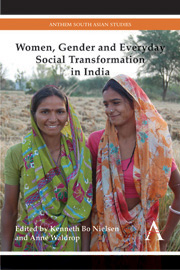Book contents
- Frontmatter
- Contents
- Acknowledgments
- Women and Gender in a Changing India
- PART I WORK, TECHNOLOGY, ASPIRATIONS
- Chapter One Today's ‘Good Girl’: the Women Behind India's BPO Industry
- Chapter Two Gender, Intersectionality and Smartphones in Rural West Bengal
- Chapter Three The Introduction of Electricity in the Sundarban Islands: Conserving or Transforming Gender Relations?
- Chapter Four Changing Consumption and the Negotiation of Gender Roles in Kerala
- Chapter Five Gender, Work and Social Change: Return Migration to Kerala
- Chapter Six Showtime and Exposures in New India: the Revelations of Lucky Farmhouse
- PART II DEMOCRACY AND THE DEVELOPMENTAL STATE
- PART III ASSERTIONS AND ACTIVISM
- About the Editors and Contributors
Chapter Two - Gender, Intersectionality and Smartphones in Rural West Bengal
from PART I - WORK, TECHNOLOGY, ASPIRATIONS
Published online by Cambridge University Press: 05 October 2014
- Frontmatter
- Contents
- Acknowledgments
- Women and Gender in a Changing India
- PART I WORK, TECHNOLOGY, ASPIRATIONS
- Chapter One Today's ‘Good Girl’: the Women Behind India's BPO Industry
- Chapter Two Gender, Intersectionality and Smartphones in Rural West Bengal
- Chapter Three The Introduction of Electricity in the Sundarban Islands: Conserving or Transforming Gender Relations?
- Chapter Four Changing Consumption and the Negotiation of Gender Roles in Kerala
- Chapter Five Gender, Work and Social Change: Return Migration to Kerala
- Chapter Six Showtime and Exposures in New India: the Revelations of Lucky Farmhouse
- PART II DEMOCRACY AND THE DEVELOPMENTAL STATE
- PART III ASSERTIONS AND ACTIVISM
- About the Editors and Contributors
Summary
This chapter explores the gendered use of mobile phones in Janta village in rural West Bengal in relation to intersecting class and kinship hierarchies. I focus specifically on the appropriation of smartphones as, when the fieldwork for this research took place in 2012–13, most villagers had recently acquired them. Few studies (Tenhunen 2008a; Doron 2012; Tacchi et al. 2012; Jouhki 2013) have illustrated how women in different parts of India have experienced the opportunity to use mobile phones as a major asset, although women's access to mobile telephony tends to be more restricted in comparison to men's. In this chapter, my aim is to arrive at a nuanced understanding of women's phone use by examining how phones both mediate and co-constitute gender at the intersection of multiple social hierarchies in rural West Bengal. I argue that to understand how mobile phone use is shaped by and reshapes gender, it is necessary to explore how the physical properties of phones determine technical affordances – that is, the possibilities for action – according to the users' gender, but also such parameters of identity as class and education. In order to explore the social transformations at work, I examine how phones mediate both interaction and communication.
Much of the anthropological research on the uses of mobile phones have in common an emphasis on how technologies tend to reinforce existing cultural patterns and, especially, adherence to kinship patterns (Horst and Miller 2006; Barendregt 2008; Archambault 2010). Gender and technology studies, in turn, have sought to understand why and how modern Western technology has emerged as a male domain (Oakley 1974; Cockburn 1983; Kramarae et al. 1988; Wajcman 1991). As Wajcman (1991) points out, feminists have long viewed the symbolic representation of technology as sharply gendered. Commanding new technologies is a highly mythologized and valued activity since it signifies being involved in directing the future. Consequently, men’s affinity with technology is integral to the constitution of male gender identity and the culture of technology.
- Type
- Chapter
- Information
- Women, Gender and Everyday Social Transformation in IndiaA Revisionary History, pp. 33 - 46Publisher: Anthem PressPrint publication year: 2014



